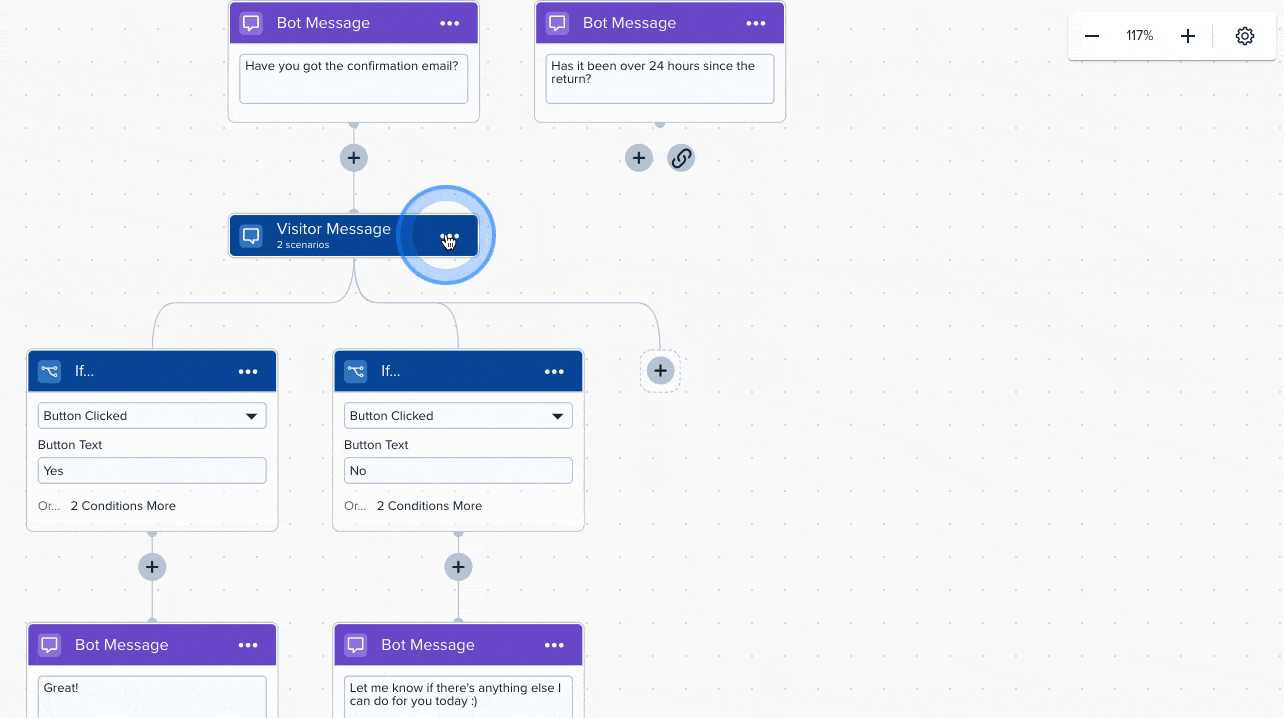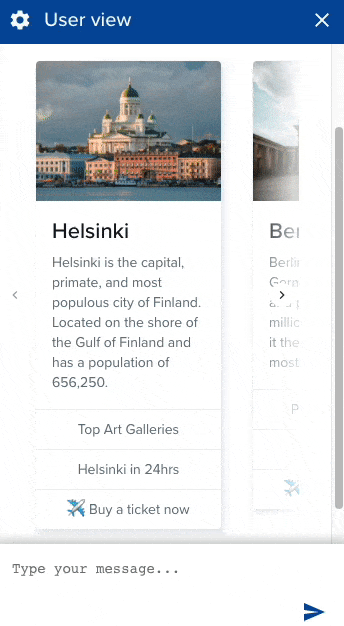A dialogue builder is a tool used to create automated conversation flows for a chatbot or a virtual agent. Chatbots and virtual agents are often used in customer service automation to help resolve customer queries, especially simple or repetitive ones that don’t require human intervention. A dialogue builder allows customer service teams to guide users through a conversation with various options to resolve their issue.
Dialogue builders for chatbots vs. virtual agents
Before diving into dialogue builder specifics, it’s important to understand the difference between traditional chatbots and AI-powered virtual agents, because their dialogue building tools will work quite differently.
Chatbots make use of rule-based software, which means they've been programmed to answer responses to specific questions. Chatbot dialogue builders allow you to create decision trees that guide the conversation in a logical and sequential way. Essentially, they are programmed to recognize selected keywords or phrases and are programmed to respond “Y” when a customer asks “X”.
Virtual agents, sometimes also known as AI chatbots, use a branch of AI called natural language processing (NLP) to understand the way people speak and type. Using this technology, they can even respond to questions they’re not explicitly programmed to understand.
Instead of being programmed to recognize a keyword or phrase, AI chatbots and virtual agents are trained to match user intent. So while a typical chatbot might be programmed to recognize the words “order status” and reply with where the order is, it would be tripped up by typos or different phrasing. A virtual agent powered by AI, however, can understand that someone asking “Where’s my package?”, “Has my order shipped yet?” or even, “i wanna know where my ordre is” all correspond to the “order status” intent and will reply accordingly.
Although virtual agents are capable of understanding natural language, a human still has to create dialogue flows with appropriate answers, which is why an easy-to-use dialogue builder is so important.
How to create bot experiences your customers will love
5 features to look for in a dialogue builder
If you’re fielding the same type of requests over and over again, for example, a restaurant taking reservations, a simple rules-based chatbot will work well. However, if you’re looking for a way to automate all kinds of customer inquiries, you’ll want to look for some more sophisticated dialogue builder features. Here are the most important things to consider.
1. No-code vs. low-code, depending on your needs
When deciding between no-code vs. low-code solutions, you’ll want to consider who will be using this tool the most. If you have dedicated IT resources or tech-savvy team members, then a low-code solution offers flexibility and customization. If your bot will mostly be managed by your customer support team, you’ll want a no-code platform designed for non-technical users that is easy-to-use, visual, and intuitive.

Ultimate's no-code, drag-and-drop dialogue builder.
2. AI capabilities
You’ve already seen how important it is for dialogue builders (and customer service automation platforms in general) to use NLP to allow it to understand the way people talk and type naturally, but there are a few other considerations when it comes to AI capabilities.
Some AI-enabled platforms (like Ultimate's) can analyze your past support data to determine your most common customer requests and train your virtual agent to answer those questions first. This means that your bot is completely customized for your brand instead of using industry benchmark data. It also means that instead of someone on your team having to come up with all the potential questions a customer might ask, AI can identify your FAQs in seconds.
Discover your most frequently asked question with the CS Automation Explorer.
Lastly, look for a dialogue builder that includes some way to train or improve your bot. No AI technology is perfect at recognizing intents right out of the box, but by training your AI model on real data, it will learn and improve over time. This enables your virtual agent to provide your customers with more accurate answers and, in the long run, saves time for your team.
Read more about how Ultimate’s Training Center helps improve your AI’s accuracy.
3. Language capabilities
If you serve markets with multiple languages or plan to expand to them in the future, a dialogue builder that can handle multilingual support is key. Look for an automation provider that has the ability to support languages with native fluency (rather than simply translating dialogues); it will result in 10-20% more accuracy in languages other than English. Offering support in your customers' preferred language adds a personalized touch to your customer service that your customers will appreciate.
"75% of customers are more likely to buy from a brand again if they offer customer care in their native language."
4. Rich messaging features
Allowing your customers to type freely to get their message across is a great option, but sometimes it’s easier to guide your users through a dialogue flow with pre-selected options. Look for dialogue builders that support rich messaging — like buttons and image carousels — to make conversing with your customers easy and engaging.

An example of Ultimate's rich messaging image carousel.
5. CRM integrations and other integrations
One key way automated support can still feel human is by personalizing conversations with customer data found in your CRM and other backend systems. Look for a dialogue builder that supports custom API integrations. This allows your virtual agent to look up relevant information using your backoffice tools just like a human agent would, so you can insert personalized details into your conversation flows or even create an entirely different flow depending on certain criteria (e.g. if a user is logged into their account, they might be treated as a VIP and get a different dialogue flow).
How Ultimate's Dialogue Builder enables advanced conversation design
Watch James Longbotham, Senior Solution Consultant at Ultimate, demo various tools within Ultimate's Dialogue Builder.
Final words on choosing an automation platform and a dialogue builder
There is a lot to consider when choosing an automation platform beyond its dialogue building capabilities, but a good dialogue builder is fundamental for providing great automated support. And great automated support gives your agents more time to dedicate to cases that truly need a human touch.
